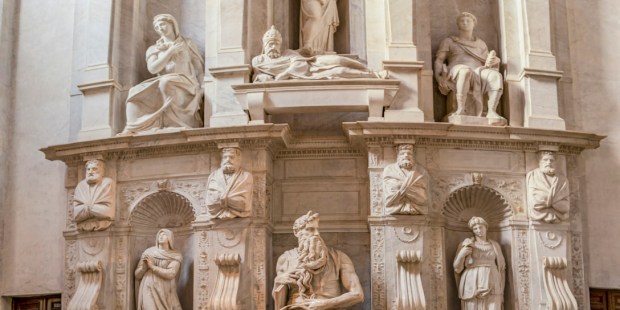The Roman minor Basilica of San Pietro in Vincoli (literally, “St. Peter in Chains”) is well known for being the home of Michelangelo’s Moses. But this church also houses a very special, often overlooked relic.
Also known as the Basilica Eudossiana, this church is an ancient one. It was rebuilt from an older foundation as early as in 432, to keep the chains that, according to tradition, were used to bind St. Peter when he was imprisoned in Jerusalem — hence its name, in Vincoli.
The feast associated with St. Peter in Chains is August 1.
Empress Licinia Eudoxia, the wife of Emperor Valentinian III and daughter of Theodosius II, had received these chains (some sources claim just a few links) as a gift from her mother, Aelia Eudocia (an exceptionally gifted poet considered a saint by both Eastern and Western churches). Aelia Eudocia, in turn, got them from St. Iuvenalis, who was then bishop of Jerusalem, where the chains were already being venerated by pilgrims. These chains were supposed to be the ones mentioned in the passage known as The Liberation of Peter, in chapter 12 of the Book of Acts. The text is relatively short. It reads:
The very night before Herod was going to bring him out, Peter, bound with two chains, was sleeping between two soldiers, while guards in front of the door were keeping watch over the prison. Suddenly an angel of the Lord appeared and a light shone in the cell. He tapped Peter on the side and woke him, saying, ‘Get up quickly.’ And the chains fell off his wrists. The angel said to him, ‘Fasten your belt and put on your sandals.’ He did so. Then he said to him, ‘Wrap your cloak around you and follow me.’ Peter went out and followed him; he did not realize that what was happening with the angel’s help was real; he thought he was seeing a vision. After they had passed the first and the second guard, they came before the iron gate leading into the city. It opened for them of its own accord, and they went outside and walked along a lane, when suddenly the angel left him. Then Peter came to himself and said, ‘Now I am sure that the Lord has sent his angel and rescued me from the hands of Herod and from all that the Jewish people were expecting.’
Acts 12, 6-11.
Licinia Eudoxia then presented the chains to Pope Leo I — a doctor of the Church better known for meeting with Attila the Hun and persuading him not to invade Italy. Legend claims that when the pope compared Eudoxia’s chains to those used to incarcerate Peter before his martyrdom (most likely in the Mamertine Prison, where Paul was also imprisoned), the two miraculously fused together.
These chains are now kept in a reliquary under the main altar in San Pietro in Vincoli — but a link can be venerated in St. Peter’s Church in Rutland, Vermont. The basilica, although consecrated in 439 by Sixtus III, has undergone several restorations throughout history, most notably under Pope Julius II (one of the main figures of the High Renaissance) during the Italian Cinquecento.




